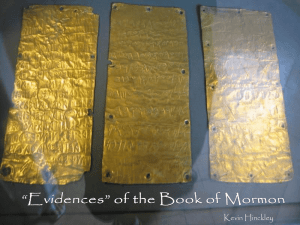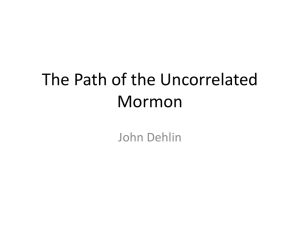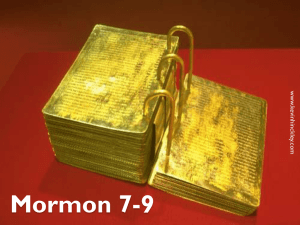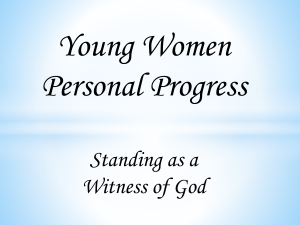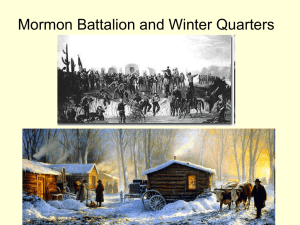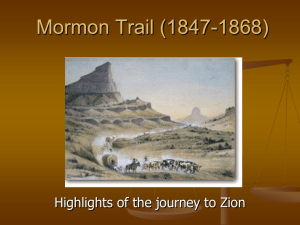The inspirational iconography of the LDS Church
advertisement
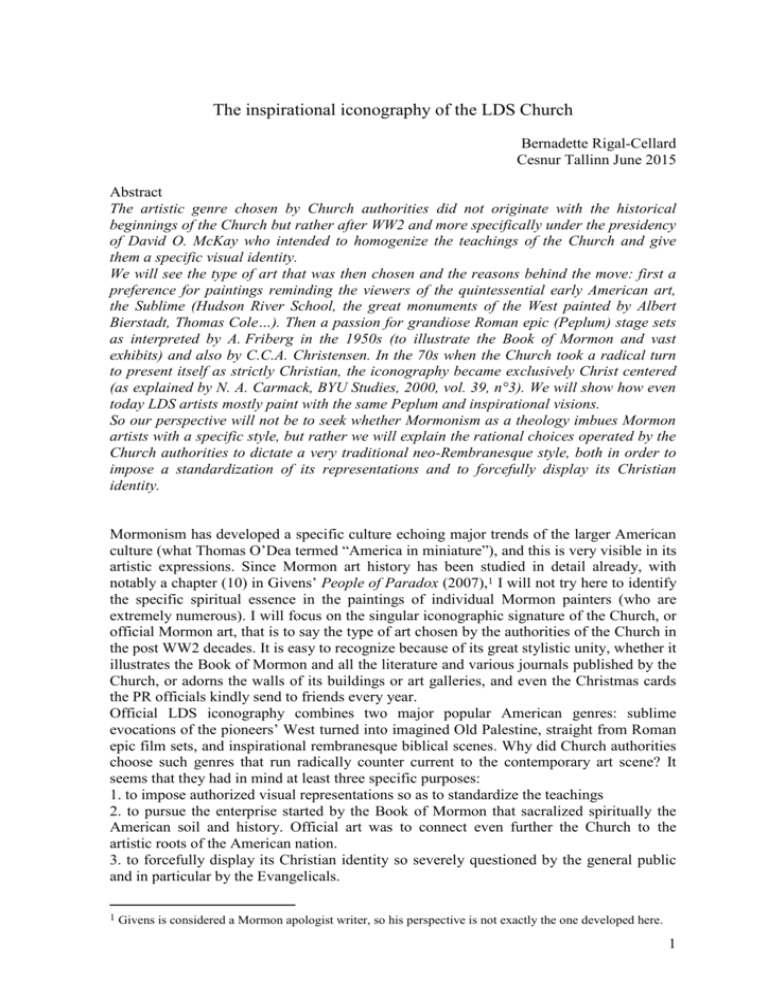
The inspirational iconography of the LDS Church Bernadette Rigal-Cellard Cesnur Tallinn June 2015 Abstract The artistic genre chosen by Church authorities did not originate with the historical beginnings of the Church but rather after WW2 and more specifically under the presidency of David O. McKay who intended to homogenize the teachings of the Church and give them a specific visual identity. We will see the type of art that was then chosen and the reasons behind the move: first a preference for paintings reminding the viewers of the quintessential early American art, the Sublime (Hudson River School, the great monuments of the West painted by Albert Bierstadt, Thomas Cole…). Then a passion for grandiose Roman epic (Peplum) stage sets as interpreted by A. Friberg in the 1950s (to illustrate the Book of Mormon and vast exhibits) and also by C.C.A. Christensen. In the 70s when the Church took a radical turn to present itself as strictly Christian, the iconography became exclusively Christ centered (as explained by N. A. Carmack, BYU Studies, 2000, vol. 39, n°3). We will show how even today LDS artists mostly paint with the same Peplum and inspirational visions. So our perspective will not be to seek whether Mormonism as a theology imbues Mormon artists with a specific style, but rather we will explain the rational choices operated by the Church authorities to dictate a very traditional neo-Rembranesque style, both in order to impose a standardization of its representations and to forcefully display its Christian identity. Mormonism has developed a specific culture echoing major trends of the larger American culture (what Thomas O’Dea termed “America in miniature”), and this is very visible in its artistic expressions. Since Mormon art history has been studied in detail already, with notably a chapter (10) in Givens’ People of Paradox (2007),1 I will not try here to identify the specific spiritual essence in the paintings of individual Mormon painters (who are extremely numerous). I will focus on the singular iconographic signature of the Church, or official Mormon art, that is to say the type of art chosen by the authorities of the Church in the post WW2 decades. It is easy to recognize because of its great stylistic unity, whether it illustrates the Book of Mormon and all the literature and various journals published by the Church, or adorns the walls of its buildings or art galleries, and even the Christmas cards the PR officials kindly send to friends every year. Official LDS iconography combines two major popular American genres: sublime evocations of the pioneers’ West turned into imagined Old Palestine, straight from Roman epic film sets, and inspirational rembranesque biblical scenes. Why did Church authorities choose such genres that run radically counter current to the contemporary art scene? It seems that they had in mind at least three specific purposes: 1. to impose authorized visual representations so as to standardize the teachings 2. to pursue the enterprise started by the Book of Mormon that sacralized spiritually the American soil and history. Official art was to connect even further the Church to the artistic roots of the American nation. 3. to forcefully display its Christian identity so severely questioned by the general public and in particular by the Evangelicals. 1 Givens is considered a Mormon apologist writer, so his perspective is not exactly the one developed here. 1 1. Unifying visually the teachings of the Church Already at the end of the 19th century, Church authorities initiated an iconographic program in order to endow their religion with a recognizable visual sacredness, somehow in the manner of the grand Catholic artistic tradition and to do so they looked to the center of the arts at the time, Paris. In 1890, they sent the painters of the murals of the Salt Lake City temple to Paris in order to train in particular at the Julian Academy.2 However, it seems that it was mostly after WW2, more specifically at the beginning of the 1960s under the presidency of David O. McKay (1951-1970), that the authorities felt the need to harmonize the texts and all documents of the Church for families and for missions, and give them a specific visual identity. To achieve this, a specific artistic style was dictated. Noel A. Carmack (BYU Studies, 2000, vol. 39, n°3) explains that a committee of artists, graphic designers, media specialists was commissioned to give a unified identity to all the printed and visual resources of the Church. One could only use the images authorized by the Church and they had to be printed by appointed printers. Artists were selected according to their style, even if they were not all Mormons, though the majority were and still are. The strategy chosen by President McKay and his team in the field of visual arts would be first a return to the historical roots of the Church and second the proof in print and paint of the Christ centeredness of Mormonism. The following presidents pursued the same strategy as we can read in an article on Gary Kapp, one of the major LDS artists today and a favorite for illustrating Church magazines, Ensign notably. His sister wrote in a 2014 piece that in his art studio hangs “a powerful and motivating quote by President Ezra Taft Benson” which reads: “I have a vision of artists putting into film, drama, literature, music and paintings great themes and great characters from the Book of Mormon. (October, 1988)” (Kapp Perry 2014). The compelling words from the prophets do impact the inner workings of artists and many have explained how they felt an urge to paint religious scenes and in particular episodes from the Book of Mormon. Kapp is again a perfect example: Perhaps the most spiritual experience in my work came about twentyfive years ago, when I was painting Western art to support my family, yet felt an overwhelming desire to paint scenes from the Book of Mormon. Diane and I had prayed and fasted that a way would be opened for me to do this and still support my family financially. One night after sleeping for several hours, I suddenly awoke with a vision’ of a painting of the conversion of Alma the Younger and the sons of Mosiah. It was so vivid that I hopped out of bed, went down to my studio and sketched it out in detail. Then I returned to bed. The next morning, a woman came to my door saying that she and her husband (Alan and Karen Ashton) wanted to commission a large religious painting. When I asked what she wanted me to paint, she said they had been thinking about the conversion of Alma and the sons of Mosiah. Stunned, I showed her the sketches I had made in the 2 I thank here Heather Belnap Jensen of BYU who sent me the manuscript of her paper on Mormon women painters in Paris around 1900, in which she mentions this episode. Thanks to her I learned that women artists went there as well, but not so much to work for the Church later as to become Professional artists as well as active members of the “New Woman movement” (Jensen 1). 2 night. I knew then that the Lord would provide a way for me to paint those Book of Mormon scenes that meant so much to me. (in Perry Kapp & Kapp 2009, p.19) 2. The historical line Mormonism emanated from a specifically American cultural landscape. The artistic atmosphere of the period is what officially LDS commissioned iconography seeks to perpetuate endlessly. Church literature—the Book of Mormon, various books, journals, Internet web sites…—mostly use paintings that belong to the Hollywood Roman epic genre, depicting characters in a dramatic ancient setting with flowing and colorful clothing, closely intertwined with the 19th century landscape painting school, that of the sublime that in the USA became the Hudson River School. It may be surprising to see that the majority of the painters of the Mormon artistic pantheon paint still to this day in the manner of the old masters of the genre, when the visual arts scene in the USA has so fantastically evolved since then. The answer may be that this fascination for the old school has a powerful didactic value. As is well known, in the visual arts as well as in literature, the young USA was at pains to produce an art that would not be imported nor imitated from the European one, in order to display its independence in the line of the political independence recently acquired. Such a vast project was to be fulfilled by the Hudson River School, the heir of the School of the Sublime. Even if this school of painting that favors vast mountainscapes imbued with a subtle light meant to evoke Transcendence was born in Europe (in the 18th century and then in 19th paintings, notably with the School of Düsseldorf), one of its major actors, Albert Bierstadt, emigrated to the United States where he established a great following, with notably Frederic E. Church, Thomas Cole, Thomas Moran, John F. Kinsett… These artists now painted the national territory, the high valley of the Hudson and gradually, as the West was being discovered, the supernatural landscapes of the Rockies and of the canyons, the new stone cathedrals far exceeding in scope those of the ancient colonial masters. The Hudson River School was at its apex from 1820 to 1870, that is to say exactly at the same time Mormonism was operating the Americanization of biblical spirituality. The Book of Mormon was the first and is still to this day one of the rare religious scriptures to sacralize explicitly the American continent. The background of its patriarchs on the Land of Promise is exactly the subject matter on the canvasses of the Hudson River school. In the book as in the paintings, the sources are in the Old world and in the Old Testament, but the restoration in the New World of the biblical message and that of the Sublime genre proclaims the prelapsarian beauty of the young and innocent nation that has been preserved by God from the sinful decadence of Europe. By selecting, today, painters who perpetuate the stylistic visions of the Hudson River School, the LDS Church reaffirms the indissoluble link between art and the sacred, between the visual expression of a culture and its spiritual undergirding. Though most Mormons in the US as well as in the rest of the world live in urban areas, official LDS illustrations seldom, if ever, portray religious scenes in an urban setting. The visual culture thus disseminated remains that of the American wilderness transcendentalized by the Book of Mormon. Another point is that already in the 19th century, it was not just their new continent that fascinated the Hudson River School artists but also the Biblical lands. Frederick Church, for one, went to the Near East and imbued his views of Jerusalem for example with the same sublime quality as the American lands. One can easily recognize in his “Jerusalem from the Mount of Olives” the subtext for the illustrations of Mormon episodes. We 3 remember that Utah’s topographical names were chosen to recall those of ancient Israel here restored to its eternal grandeur. One may also imagine that the iconographic representation of the restoration of Israel borrowed from the Orientalist genre, which was most popular in France in the 19th century and whose artists were probably familiar to not only the LDS painters going to train in Paris but to all the teachers in American art schools. Yet, of course, the LDS artists never followed the sensuous vein of the Orientalists since the human body was never to be shown naked. This spiritual and aesthetic streak was pursued in the 20th century thanks to the development of the Western movies. They imprinted on their viewers’ minds the fondness for grand narratives in grandiose settings, and they paired with the other popular Hollywood genre, that of historical epics imagined in the Roman, Egyptian or Greek empires (what the Italians called the Peplum film). One climax was the production of Cecil B. DeMille portraying the Biblical epic in vast territories familiar to both imaginative readers of the Old Testament and lovers of the Wild West. The Mormon visual agenda greatly derives from these veins as is most typically displayed in Friberg’s career, as we will soon see, yet he is definitely not unique in this regard. An interesting point is that the painters hired for the various departments of the Church are most often of Scandinavian stock and the major ones were actually born in Northern Europe. Since, even though a lot of saints are of the same stock in Utah, they are no longer the majority in the Church, there must be a reason behind such overrepresentation in the LDS art world: may I suggest it might be due to their being brought up in a Protestant culture and to their being less influenced by the more innovative but often shamelessly sensuous art of the rest of Europe, of France notably? The commission was to dwell exclusively in fully clothed inspirational biblical scenes, planted in “sublime” backdrops. A. Friberg et C.C.A. Christensen, Greg Olsen are among the top official laureates. Arnold Friberg (1913-2010), the master artist most would later imitate, is clearly Scandinavian: his mother was Norwegian, his father Swedish. Both migrated to America and converted to Mormonism. Arnold was baptized at the age of 8. He studied at the Chicago Academy of Fine Arts, then in New York City alongside Norman Rockwell. He moved to Utah in 1949 with his wife. In 1953 he was in Hollywood where he was hired to be the chief artist-designer of Cecil B. DeMille and he notably painted fifteen promotional paintings for The Ten Commandments. He is the mastermind Mormon painter since his works combines all the genres mentioned above: religion, pepla, westerns and scenes of national history such as The Prayer at Valley Forge, and Winter at Valley Forge. He is mostly famous for his twelve paintings for the Book of Mormon. In a Deseret News article Trent Toone explained the making of those masterpieces. These were not commissioned by the Church leaders but by a lady, Adele Cannon Howells, who was the church’s general president of the Primary from 1943 to 1951 and personally commissioned him to paint a series of twelve paintings (1,000 dollars each) to “mark the 50th year of The Children’s Friend magazine. They were supposed to run every month during the anniversary year but they took longer to paint.” Howells’ family donated them to the Church after her death and they now adorn the Book of Mormon exhibit at the Conference Center. “Friberg turned to LDS Church leaders for historical and doctrinal suggestions, questions about antiquity and archeological findings, hair length and clothing, but was surprised to find their opinions varied” and so he grew frustrated and finally decided to follow his own ideas. He was asked to paint great sermons, but “he wanted to paint heroes that appeared legendary in stature,” to correspond to Howells’ vision. 4 “The muscularity in my paintings is only an expression of the spirit within,” Friberg said in an interview. “When I paint Nephi, I’m painting the interior, the greatness, the largeness of spirit. Who knows what he looked like? I’m painting a man who looks like he could actually do what Nephi did.” (Barrett & Black 2005, quoted by Toone). Friberg said that he always sought divine guidance: “What I do I am driven to do. I follow the dictates of a looming and unseen force,” (quoted in Barrett & Black 2005). Toone concluded his article in these words: “No one could have suspected that these artistic works would be so inspirational, and that the LDS Church would eventually reproduce them in copies of the Book of Mormon that were translated and sent out worldwide”. Indeed they indelibly imprint forever in the minds and hearts of the readers of the Book of Mormon his visions of the tribes’ adventures in America. Friberg masterfully encapsulated in those paintings the essence of contemporary Mormon iconography: the Bible staged by Cecil B. DeMille. The other major LDS painter of Scandinavian origin, Carl Christian Anton Christensen (1831-1912) was born in Denmark. He converted to Mormonism in 1850, became a missionary in his own country, then in Sweden, and with his wife he migrated to the US and took part in the handcarts trek. He first designed theater sets, and then specialized in the grandiose illustration of the saints’ history, in particular that of the trek. He painted scenes of the Book of Mormon that were used for Sunday school, and murals for the temples in Manti and St George. BYU possesses most of his works. He is mostly famous for The Mormon Panorama (completed in 1878) which is composed of 22 paintings, each 6.5 feet by 10 feet (altogether 53 meters long), “stitched together to create a create a connected, rolling narrative…[They] depict key moments from early Church history such as the martyrdom of Joseph Smith and the Saints’ exodus from Missouri” (Swensen 2015). They are completely different from the paintings of Friberg for they resemble Currier and Ives prints. Manti temple features also great murals by a fabulous woman artist Minerva Teichert (1888-1976) (my favorite LDS artist). She was born in Ogden. She studied at the Art institute in Chicago and in New York and lived with her family in Wyoming. Her style is very personal, though connected to those we have mentioned since she specialized in Western scenes and religious ones. She painted 42 murals from the Book of Mormon and more for the Manti temple walls. Her iconography is clearly in the Orientalist style, with explosive colors, somehow in the peplum tradition but with far lighter brushstrokes so that overall her works are more discreet, subdued and definitely reach less at grandiose pomposity than Friberg’s paintings. Her best known painting is Christ in a Red Robe. Though it is an oil painting, it exudes the delicate feel of a drawing. Only the figure of Christ is clearly delineated and brightly colored. The red robe evokes his second coming, as announced by Isaiah (63:1-2). The women around him are sketched in light curves, in pale ochre colors, framing his centrality and divine uniqueness. Many more painters work within the same aesthetic combination of Western and biblical illustrations and are regularly commissioned by the Church leaders or members. One favorite of Mormon iconography is Gary Kapp whose explanations about his spiritual inspiration I quoted above. He was born in Ogden in 1942, studied at BYU and lives in Provo, a devout saint. Like Friberg and Christensen he specializes in film sets, grandiose mountainscapes in the Sublime style, staging archetypal Indians in the Rockies, and in biblical scenes in the Friberg’s style. 5 Quite similar in style and inspiration, Greg Olsen, born in 1958, was raised in Idaho and he studied in Utah. His inspirational paintings, usually of Christ on earth, are represented in religious temples in more than 20 countries.3 3. The hyper Christ-centered subject matter Clearly LDS authorities did not abide by the same iconoclastic principles characteristic of early Protestantism that banished all aesthetic pursuits seen as the mark of the Roman Catholic Babylon. Paradoxically though, even within Protestantism a major shift took place in the recent decades that have seen Protestant iconoclasm turn into iconolatry, mainly among many Evangelical groups. These churn out thousands of insipid “inspirational” images and reproduce by the millions some representations of Christ painted by essentially German artist Heinrich Hoffman or Warner Sallman. Interestingly, in their elaboration of their official artistic trademark, LDS authorities borrowed many illustrations from the same source as the Evangelicals. It is this conjunction that I will present here. One notes a clear fascination of the LDS Church leaders for imitators of Rembrandt. This might be linked to the fact that he himself liked to paint the members of the Jewish community in Amsterdam and scenes of the Old Testament, bequeathing a cornucopia of biblical icons in the grand style that imitators multiplied infinitely. Since using original Rembrandt paintings would not identify the illustrations as exclusively Mormon (or Evangelical), the strategy of both groups was rather to appropriate those of lesser-known followers. Two of the most reproduced artists by Evangelicals and LDS alike are Carl Henrich Bloch (1834-1890) and Heinrich Hoffmann (1824-1911). Not coincidentally Bloch was from Denmark and Hoffmann from Germany. Bloch specialized in rural, historical and biblical scenes in a neo-rembranesque style that became appreciated in America (notably his Transfiguration). Hoffmann painted many religious scenes in the tradition of the Dutch, German and Italian masters. He was very famous in his lifetime and grew even more popular later in the USA. Four of his major works hang in the neogothic Riverside Church in New York City. His Portrait of Christ at 33 has been reproduced millions of times in the US as well as Jesus at Gethsemane (1890) and Christ and the rich young ruler (1889). These are among the major icons of the LDS Church with the just as famous portrait of Christ by Warner Sallman (1892-1968). Painted in 1941 the portrait was reprinted at least 500 million times according to its publisher…4 Sallman was an evangelical painter from Chicago who painted many other Biblical scenes all in the hyperrealist peplum genre; they were bequeathed to Anderson evangelical university in Indiana. I first saw this portrait of Jesus in the lounge of Evangelical friends in the US (with an immediate dislike for it!) and then discovered it also in a LDS house, which surprised me greatly at the time. This is what led me to investigate the connection. I must thank here Noel A. Carmack for his study published in 2000 in BYU Studies for not only did he confirm my own hypotheses on the issue but he clarified and analyzed it brilliantly: the usage by the Mormons of the archetypal icon of the Evangelicals is clearly meant to demonstrate to their archenemies that they are as Christian as them, if not more so. 3 Though the artists I mention are LDS, many others will paint in the same vein without belonging necessarily to the Church since the Western and spiritual genre is extremely popular in the USA in general and in the West in particular with hundreds of galleries and museums specializing in this type of art. 4 Figure given by its publisher, Kriebel & Bates : http://www.warnersallman.com/collection/images/head-ofchrist/ (April 2012). 6 Salman’s Christ as well as Hoffmann’s pasted all over the walls and publications of the saints testify visually of the affirmation by the Church that it is 100% Christ centered. In sculpture, the replica of the Christus statue by Albert Bertel Thornvaldsen (1770-1844) (again not coincidentally Danish and Icelandic) reigns supreme. Again not coincidentally it was offered to the Church at the onset of the Christ centeredness campaign: by the First Counselor Stephen L Richards to President David O. McKay (1951-1959). In 1966 it was placed in the North Visitors Center on Temple Square in Salt Lake City. The artistic choice to hammer down the newly expanded Christ centeredness was first made public in the Mormon Pavilion of New York’s World Fair in 1964-65.5 One must also note that the period corresponds to the international boom of the Church worldwide. The authorities commissioned an LDS painter, Sydney E. King, for a mural depicting in twelve scenes the life of Christ. It was also for the Fair that a Florentine sculptor, Aldo Rebachi, was commissioned to draft a replica of Christus, and as Florence S. Jacobsen stated: “It was intended to help visitors understand that Latter-day Saints (or Mormons) are Christians.” (http://eom.byu.edu/index.php/Christus_Statue). It was later placed in the Visitors center of the Los Angeles Temple. Harry Anderson (1906-1996), a Seventh day Adventist was commissioned to paint also the life of Christ for the Pavilion and the Visitors center in Salt Lake. His portrayals of Christ have been reproduced massively, notably on the covers of Ensign until at least 1985. Noel A. Carmack produced a chart that traces the incredibly increase of the representations of Christ on the covers of this Church journal. Parallel with the modification of certain phases of the temple rituals from the 1980s’ on, the saints were faced with an even greater number of Christ images in all the productions of the Church: journals, films, documentaries, gift objects, decorative knick knacks, calendars and Christmas cards. Conclusion It was thus clearly to demonstrate urbi et orbi to Christendom that the LDS Church was perfectly orthodoxically Christian that the Authorities in Salt Lake chose a particular art school and dictated precise criteria to artists. Their innumerable portraits of Christ and Biblical scenes would prove that their own interpretation of the Bible and its new revelation, the Book of Mormon, did not contradict the official Christian doxa, but on the contrary enriched it by grounding it in a specifically blessed territory: America the Beautiful, or more exactly the American West the Beautiful. Carmack in a most stimulating chapter explains how the images of Christ should also serve as role model for young saints: as masculine but also magnanimous, he was the ideal to be strengthened during the decades that saw the coming out of homosexuals in the rest of the nation. I must say that with his always long hair and soft features, the Christ of Mormon icons evokes more often than not the effete Jesus of the hippies rather than the cowboy heroes of the West, an ambiguity that must have led to a lot of debates behind the closed doors of the editorial rooms. The Church controls a huge production industry that inundates its saints and society at large with stereotypical representations of religious scenes and of Christ, meant to reassure within and without the community that it adheres to a specifically American popular culture. LDS art blends in one single iconographic program two of the ancient pillars of the nation, the Bible and the love for the American land. Thus, the program fulfills the quest for a visual identity that would summon the celestial world through sublime landscapes. 5 Brent L. Top analyzes the impact of the Exhibition on the future on Mormonism in “Legacy of the Mormon Pavilion…” 7 This is perfectly encapsulated in the “product description” of Greg Olsen’s Deseret book Walk with me: the Paintings of Greg Olsen that will conclude my presentation: The finest inspirational art enables us to leave the stormy, rocky, and troubled world behind and enter the Lord's realm of transcendent peace and happiness. Featuring 84 stunning paintings, this collection from beloved artist Greg Olsen reminds us that the kingdom of God is not only a place, but also a concept — a spiritual destination for the believing and the pure in heart. Uplifting quotes, scriptural passages, and descriptive text from the artist illuminate the meanings of this rich variety of paintings, which includes lush landscapes, classic Americana, and inspiring renderings of the Savior Himself. A perfect gift for loved ones, this beautiful volume helps us experience heaven not only as a distant hope on the horizon, but also as our sanctuary moment by moment. (https://deseretbook.com/p/walk-me-paintings-greg-olsen-79832) References BARRETT, Robert T. Barrett, BLACK, Susan E. “Setting a Standard in LDS Art: Four Illustrators of the Mid-Twentieth Century”. BYU Studies (2005)44:2. CARMACK, N. A. “Images of Christ in Latter-day Saint Visual Culture”. BYU Studies, (2000)39:3. 18-76. GIVENS, Terryl L. People of Paradox: a History of Mormon Culture. Oxford UP, 2007. JENSEN, Heather Belnap “Artistic Frontiers: Mormon Women Artists in Paris, c. 1900”. Manuscript of a paper presented at the 2013 Nineteenth-Century French Studies conference in Raleigh, N.C. and part of a book-length manuscript, Artistic Frontiers: Mormon Women Artists Abroad, 1880-1945. KAPP PERRY, Janice. “My Brother, Gary Kapp, An Artist and a Gentle Man”. Meridian Magazine (Latter-day saints shaping their world). August 21, 2014. http://ldsmag.com/article-1-14781/ ---- and Gary L. Kapp. Another Witness: Music and Art That Testify of Christ. Covenant Communications, 2009. KOGAN, Nathaniel Smith. “The Mormon Pavilion: Mainstreaming the Saints at the New York World’s Fair, 1964–65”. Journal of Mormon History. 35:4 (fall 2009). 1-52. SWENSEN Jason. “BYU to again display famed 'Mormon Panorama'”. LDS Church News, Friday, May 29 2015http://www.deseretnews.com/article/865629581/BYU-toagain-display-famed-Mormon-Panorama.html?pg=all TOONE, Trent. “Insight into Arnold Friberg's Book of Mormon paintings”. Deseret News. Monday, May 21, 2012. Also: http://trenttoone.com/associating-with-friberg-fine-art/ TOP, Brent L. “Legacy of the Mormon Pavilion: Success at the 1964–65 New York World’s Fair helped reshape our approach to preaching the gospel.” Ensign, Oct. 1989. https://www.lds.org/ensign/1989/10/legacy-of-the-mormon-pavilion?lang=eng 8
